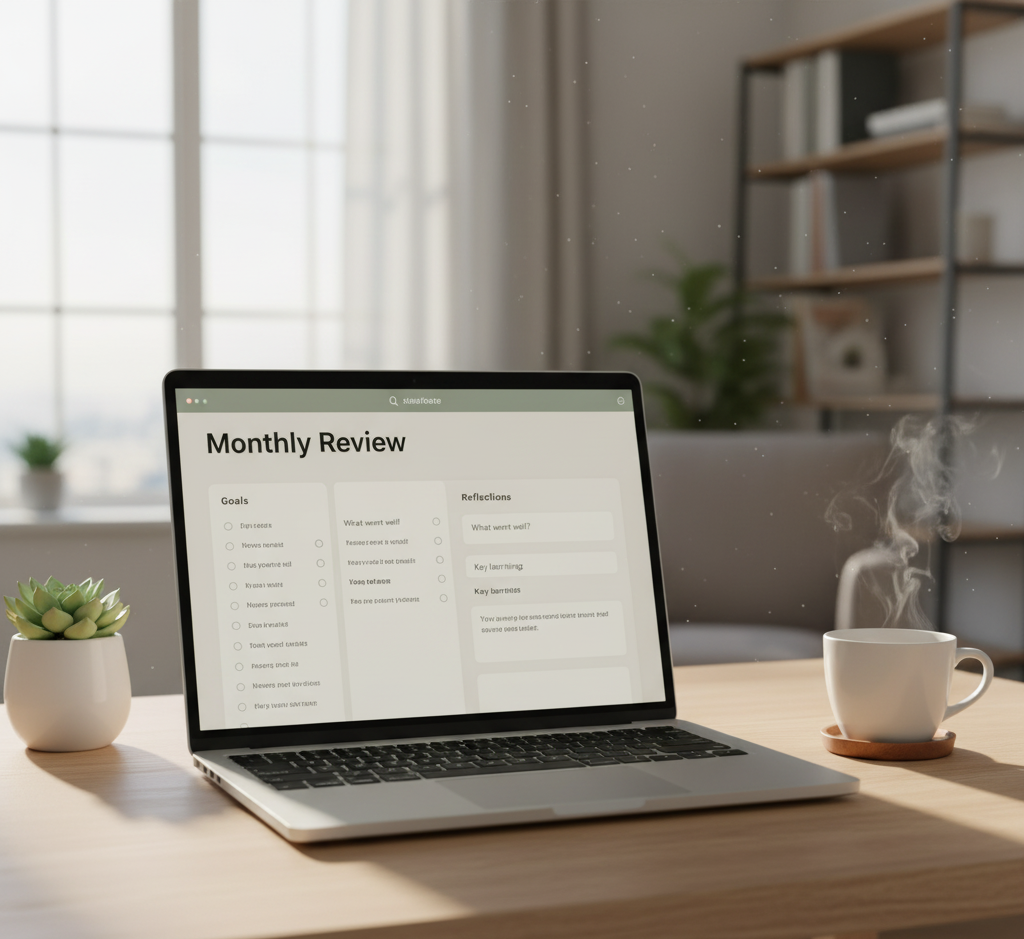A mindful approach to reviewing your month — without burnout, guilt, or overwhelm.
Ever reach the end of a month and think, “Wait… what did I actually do?” You remember being busy — maybe even exhausted — but you can’t quite trace where all that energy went. That’s the sign you need a monthly review system that’s designed for you, not some productivity guru on YouTube.
I used to dread reviews. They felt like a chore — a judgment day where I’d list what I didn’t finish. Then I discovered something: the best review system isn’t about measuring output. It’s about realignment — noticing patterns, refining focus, and reconnecting with what matters most.
This guide will help you design a monthly review system that sticks, not because it’s rigid, but because it fits your natural rhythm. By the end, you’ll know how to reflect effectively, plan mindfully, and actually look forward to your monthly reset.
Why Monthly Reviews Matter More Than You Think
If weekly reviews keep you on track, monthly reviews help you see the bigger picture. They give you distance — enough to notice trends, energy shifts, and blind spots that daily tasks hide.
A well-done review turns chaos into clarity. It reminds you that progress isn’t always visible week to week — but it is there, quietly stacking up.
Here’s what a monthly review can do for you:
- Reveal where your time actually goes
- Highlight what energizes (and drains) you
- Help you make smarter commitments next month
- Reinforce progress so you stay motivated
Key takeaway: A monthly review isn’t about perfection — it’s about perspective.
Step 1: Create the Right Environment for Reflection

Before you even touch your planner or laptop, set the scene. A review isn’t another to-do — it’s a ritual of recalibration.
Choose Your Setting
Find a quiet, comforting space where your brain can slow down. Maybe that’s your desk with a candle lit, or your favorite café on a slow Sunday afternoon.
Set the Mood
- Play lo-fi or ambient music
- Make your favorite drink
- Disconnect from notifications
Give Yourself Permission
This isn’t about fixing yourself; it’s about understanding yourself. You’re not auditing your worth — you’re exploring your patterns.
Mini-story: I started doing my reviews at a local café with no Wi-Fi. The first few times, I felt twitchy without tabs open. But by week three, I realized how refreshing it was to think without inputs. Now, it’s a highlight of my month.
Key takeaway: Treat your monthly review like a conversation with your future self — not a performance review.
Step 2: Gather Your Data Without the Overwhelm
Data sounds cold, but it’s just information — stories in numbers. To make your review meaningful, gather what reflects your real month.
Your Monthly Review Data Sources
- Calendar: What actually filled your days
- Task app or planner: What got done vs. postponed
- Journal or notes app: Emotional patterns, wins, frustrations
- Finance tracker: Where money went (and what it said about priorities)
Don’t overcomplicate this. You don’t need spreadsheets or color-coded dashboards (unless that genuinely excites you).
If you’re more visual, try apps like Notion, Reflectly, or Tana — I personally use Notion’s “Month in Review” template to capture highlights and lowlights. It’s been a quiet game-changer for clarity.
Key takeaway: Only collect what helps you reflect, not what makes you anxious.
Step 3: Ask Better Questions
The quality of your review depends on the quality of your questions. Instead of “Did I do enough?”, ask “Did I do what mattered most?”

Here are a few thoughtful prompts to guide your reflection:
Reflect
- What moments made me feel most fulfilled this month?
- What drained my energy — and why?
- What habits supported me, and which sabotaged me?
Review
- What goals moved forward, even slightly?
- What challenges taught me something important?
- What did I overcommit to or neglect?
Realign
- What do I want more (or less) of next month?
- What’s one small shift that could create more flow?
- What am I ready to release?
Personal tip: I always end my review by writing one “lesson of the month.” It’s often something small — like “say no faster” or “start slower.” Over time, those lessons become a compass.
Key takeaway: The goal isn’t to track every detail — it’s to listen to what your month is trying to tell you.
Step 4: Visualize Your Month — Literally
Our brains process visuals faster than words. That’s why mapping your month helps you see patterns you’d otherwise miss.
Create a Monthly Mind Map
Use a tool like Miro, Xmind, or a blank Notion page to map key themes:
- What worked
- What didn’t
- What surprised you
- What you’re focusing on next
This simple visual snapshot keeps your insights tangible. It’s also easier to review later — no endless scrolling through journal entries.
Key takeaway: Seeing your month at a glance transforms reflection from abstract thought to actionable insight.
Step 5: Design Your Monthly Reset Ritual
Once you’ve reflected and visualized, it’s time to reset with intention.

The Three Rs of a Monthly Reset
- Review what mattered most.
- Refine your priorities — what stays, what goes.
- Recommit to the habits and goals that align.
A good reset is light but meaningful. I usually end mine by writing three sentences:
- What I’m proud of
- What I’m releasing
- What I’m focusing on next
Optional Add-Ons
- Create a desktop wallpaper with your focus word
- Adjust your calendar blocks to match new goals
- Plan a “celebration ritual” (a solo walk, favorite meal, or quiet evening off)
Key takeaway: Reflection without reset is rumination. Use what you’ve learned to shape what comes next.
Step 6: Choose a System That Actually Fits You
Here’s the truth: the best monthly review system isn’t a one-size-fits-all template. It’s the one you’ll actually do.
So let’s look at a few popular approaches — and which type they suit best.
1. The Minimalist Review
Best for: Overthinkers or burnout-prone professionals
Focus on three prompts:
- What went well?
- What didn’t?
- What’s next?
It takes 15 minutes, tops. Perfect if your energy for reflection is low.
2. The Structured Review

Best for: Data-driven minds
Use a Notion or Excel template to track metrics: habits, goals, sleep, energy, focus.
It’s satisfying — just be sure you’re tracking insight, not just numbers.
3. The Reflective Journal
Best for: Deep thinkers or creative professionals
Spend 30–45 minutes free-writing your thoughts.
This is where emotions, creativity, and clarity meet.
4. The Hybrid Review (My Favorite)
Combine structure and intuition:
- Start with a few metrics
- Add reflective prompts
- End with a summary paragraph
Key takeaway: The best system is the one that feels like you — not another version of “should.”
Step 7: Make It Stick
Even the best system won’t work if it feels like a burden. The secret? Make your review something you look forward to.
How to Make Your Monthly Review a Habit
- Anchor it to a date (like the first Sunday of the month)
- Keep it short — better a 20-minute review every month than a 2-hour one you skip
- Reward yourself afterward (your brain loves closure)
- Track it lightly — even a checkbox in your planner builds momentum
I’ve kept my review ritual for over two years, and it’s never been about discipline. It’s about peace — the relief of knowing I’m not running blind.
Key takeaway: Consistency comes from connection, not pressure.
Conclusion: Review to Realign, Not to Judge

A monthly review is less about productivity and more about presence. It’s how you stop drifting through months and start living them.
You don’t need a perfect system. You just need your system — one that feels human, flexible, and rooted in awareness.
If you’re ready to design your own version, try using Notion’s “Monthly Reflection” template here — or check out my previous article, Organize Your Learning Stack: Build a System That Actually Sticks, to make your reflection practice even more effective.
Final thought: Reviewing your month isn’t about looking back with judgment — it’s about looking forward with wisdom.



